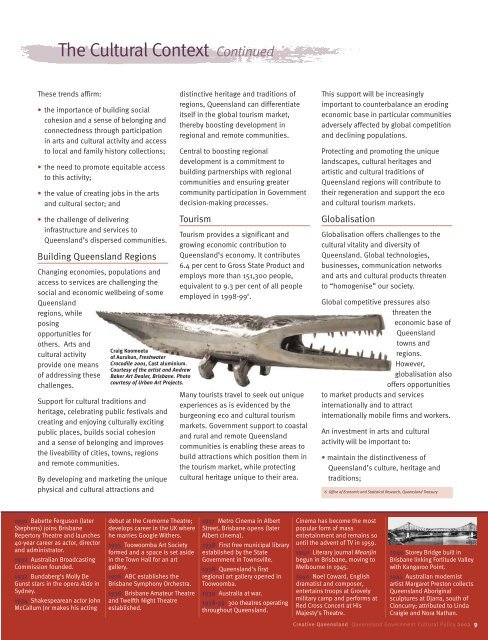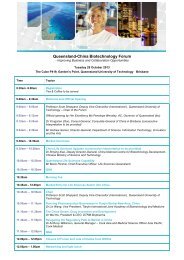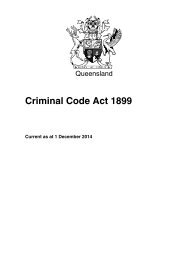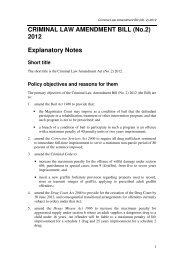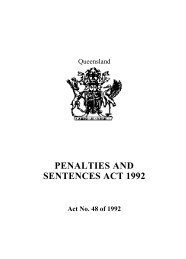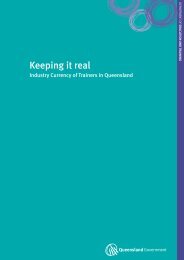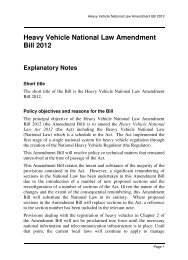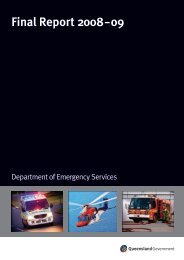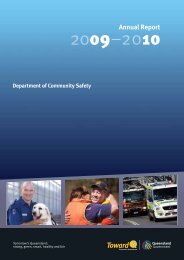AQ034 Cultural Policy.qxd - Arts Queensland
AQ034 Cultural Policy.qxd - Arts Queensland
AQ034 Cultural Policy.qxd - Arts Queensland
- No tags were found...
You also want an ePaper? Increase the reach of your titles
YUMPU automatically turns print PDFs into web optimized ePapers that Google loves.
The <strong>Cultural</strong> Context Continued<br />
These trends affirm:<br />
• the importance of building social<br />
cohesion and a sense of belonging and<br />
connectedness through participation<br />
in arts and cultural activity and access<br />
to local and family history collections;<br />
• the need to promote equitable access<br />
to this activity;<br />
• the value of creating jobs in the arts<br />
and cultural sector; and<br />
• the challenge of delivering<br />
infrastructure and services to<br />
<strong>Queensland</strong>’s dispersed communities.<br />
Building <strong>Queensland</strong> Regions<br />
Changing economies, populations and<br />
access to services are challenging the<br />
social and economic wellbeing of some<br />
<strong>Queensland</strong><br />
regions, while<br />
posing<br />
opportunities for<br />
others. <strong>Arts</strong> and<br />
cultural activity<br />
provide one means<br />
of addressing these<br />
challenges.<br />
Craig Koomeeta<br />
of Aurukun, Freshwater<br />
Crocodile 2001, Cast aluminium.<br />
Courtesy of the artist and Andrew<br />
Baker Art Dealer, Brisbane. Photo<br />
courtesy of Urban Art Projects.<br />
Support for cultural traditions and<br />
heritage, celebrating public festivals and<br />
creating and enjoying culturally exciting<br />
public places, builds social cohesion<br />
and a sense of belonging and improves<br />
the liveability of cities, towns, regions<br />
and remote communities.<br />
By developing and marketing the unique<br />
physical and cultural attractions and<br />
distinctive heritage and traditions of<br />
regions, <strong>Queensland</strong> can differentiate<br />
itself in the global tourism market,<br />
thereby boosting development in<br />
regional and remote communities.<br />
Central to boosting regional<br />
development is a commitment to<br />
building partnerships with regional<br />
communities and ensuring greater<br />
community participation in Government<br />
decision-making processes.<br />
Tourism<br />
Tourism provides a significant and<br />
growing economic contribution to<br />
<strong>Queensland</strong>’s economy. It contributes<br />
6.4 per cent to Gross State Product and<br />
employs more than 151,300 people,<br />
equivalent to 9.3 per cent of all people<br />
employed in 1998-99 6 .<br />
Many tourists travel to seek out unique<br />
experiences as is evidenced by the<br />
burgeoning eco and cultural tourism<br />
markets. Government support to coastal<br />
and rural and remote <strong>Queensland</strong><br />
communities is enabling these areas to<br />
build attractions which position them in<br />
the tourism market, while protecting<br />
cultural heritage unique to their area.<br />
This support will be increasingly<br />
important to counterbalance an eroding<br />
economic base in particular communities<br />
adversely affected by global competition<br />
and declining populations.<br />
Protecting and promoting the unique<br />
landscapes, cultural heritages and<br />
artistic and cultural traditions of<br />
<strong>Queensland</strong> regions will contribute to<br />
their regeneration and support the eco<br />
and cultural tourism markets.<br />
Globalisation<br />
Globalisation offers challenges to the<br />
cultural vitality and diversity of<br />
<strong>Queensland</strong>. Global technologies,<br />
businesses, communication networks<br />
and arts and cultural products threaten<br />
to “homogenise” our society.<br />
Global competitive pressures also<br />
threaten the<br />
economic base of<br />
<strong>Queensland</strong><br />
towns and<br />
regions.<br />
However,<br />
globalisation also<br />
offers opportunities<br />
to market products and services<br />
internationally and to attract<br />
internationally mobile firms and workers.<br />
An investment in arts and cultural<br />
activity will be important to:<br />
• maintain the distinctiveness of<br />
<strong>Queensland</strong>’s culture, heritage and<br />
traditions;<br />
6 Office of Economic and Statistical Research, <strong>Queensland</strong> Treasury<br />
1930 Babette Ferguson (later<br />
Stephens) joins Brisbane<br />
Repertory Theatre and launches<br />
40-year career as actor, director<br />
and administrator.<br />
1932 Australian Broadcasting<br />
Commission founded.<br />
1932 Bundaberg’s Molly De<br />
Gunst stars in the opera Aida in<br />
Sydney.<br />
1934 Shakespearean actor John<br />
McCallum Jnr makes his acting<br />
debut at the Cremorne Theatre;<br />
develops career in the UK where<br />
he marries Googie Withers.<br />
1935 Toowoomba Art Society<br />
formed and a space is set aside<br />
in the Town Hall for an art<br />
gallery.<br />
1936 ABC establishes the<br />
Brisbane Symphony Orchestra.<br />
1936 Brisbane Amateur Theatre<br />
and Twelfth Night Theatre<br />
established.<br />
1937 Metro Cinema in Albert<br />
Street, Brisbane opens (later<br />
Albert cinema).<br />
1938 First free municipal library<br />
established by the State<br />
Government in Townsville.<br />
1938 <strong>Queensland</strong>’s first<br />
regional art gallery opened in<br />
Toowoomba.<br />
1939 Australia at war.<br />
1938-39 300 theatres operating<br />
throughout <strong>Queensland</strong>.<br />
Cinema has become the most<br />
popular form of mass<br />
entertainment and remains so<br />
until the advent of TV in 1959.<br />
1940 Literary journal Meanjin<br />
begun in Brisbane, moving to<br />
Melbourne in 1945.<br />
1940 Noel Coward, English<br />
dramatist and composer,<br />
entertains troops at Grovely<br />
military camp and performs at<br />
Red CrossConcertatHis<br />
Majesty’s Theatre.<br />
68325<br />
1940 Storey Bridge built in<br />
Brisbane linking Fortitude Valley<br />
with Kangaroo Point.<br />
1941 Australian modernist<br />
artist Margaret Preston collects<br />
<strong>Queensland</strong> Aboriginal<br />
sculptures at Djarra, south of<br />
Cloncurry; attributed to Linda<br />
Craigie and Nora Nathan.<br />
Creative <strong>Queensland</strong> <strong>Queensland</strong> Government <strong>Cultural</strong> <strong>Policy</strong> 2002 9


